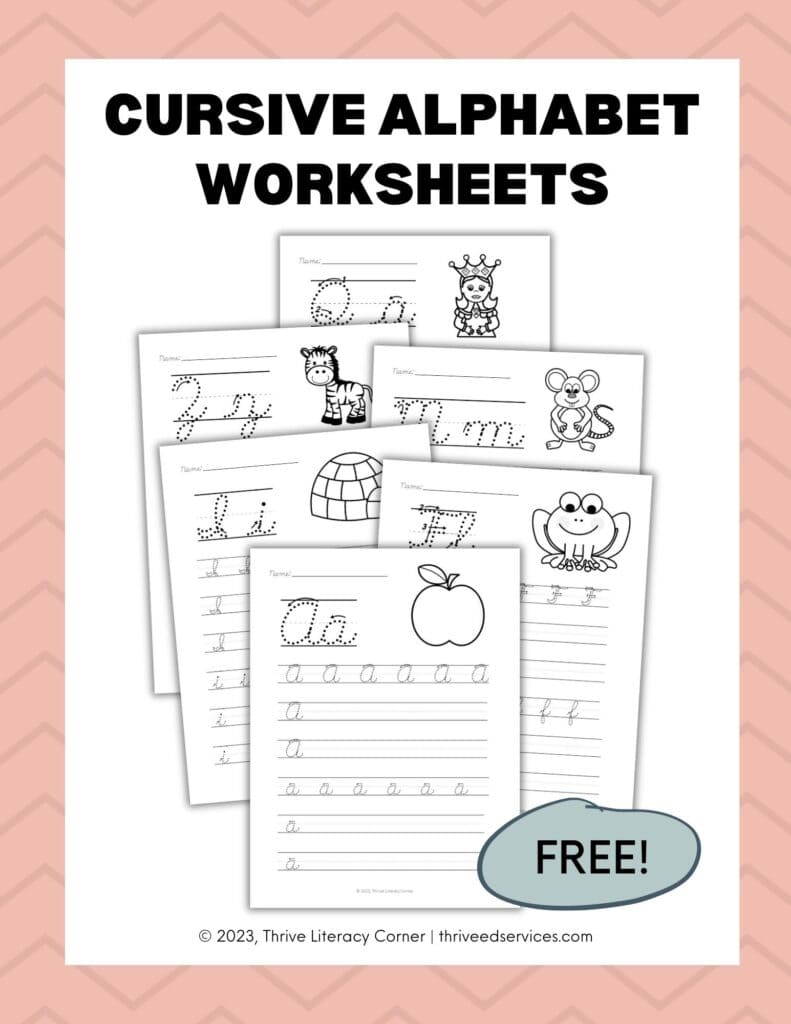Cursive Writing Benefits + Free Cursive Writing Worksheets
This post may contain affiliate links, and I will earn a commission if you purchase through these links. Please read the disclosure policy for more details.
Teaching cursive in the digital age might seem like a pointless task, but learning cursive writing can still prove to be a valuable skill. It also provides benefits supported by research that improve reading and writing.
In this article, I share the benefits of teaching cursive, especially for those with dyslexia, some tips to help you teach cursive handwriting, and some free printable cursive writing worksheets.
Click here to get your free printable cursive handwriting worksheets!

Benefits of Cursive Writing
Cursive writing offers various advantages that can improve hand-eye coordination, boost memory, and stimulate brain development, among other things.
- The continuous line emphasizes left to right directionality.
- Connected letters present fewer opportunities for the writer to reverse direction.
- Flowing, rhythmical movements are more easily executed than short straight lines and curved arcs.
- Cursive letter shapes are not reversible.
- All lower case letters begin on the line with a suitable approach stroke. This practice eliminates the need to decide where to start and in which direction to proceed.
Dyslexia and Cursive
One of the primary benefits of cursive writing is its potential to help individuals with dyslexia. Dyslexia often causes confusion with similar-looking letters, such as “b” and “d” or “p” and “q,” which can be challenging to differentiate in print. In cursive writing, however, these letters have distinct shapes, making it easier for dyslexic individuals to identify them.
Moreover, the continuous flow of cursive writing encourages students to connect letters, which promotes left-to-right reading and minimizes the likelihood of letter reversal. As a result, cursive writing can be an essential tool for dyslexic individuals to ease their reading difficulties.
The fluid motion and connected letters in cursive writing also help stimulate brain development. By engaging both the left and right cerebral hemispheres simultaneously, cursive writing enhances neural connections and boosts memory retention. The continuous movement trains your brain to establish better hand-eye coordination and keeps your mind actively engaged.
When I work with students who really struggle with their handwriting or letter reversals, cursive writing is usually a tool that works well for them.

Basics of Cursive Writing – Tips for Learning
Learning cursive letters is a skill in that can help develop good handwriting. Let’s go over the basics of cursive writing, including posture, paper position, and pencil grip.
Practicing cursive writing requires patience and time. Start by working with the cursive lowercase letters, as some of them are quite different from their printed counterparts. Then, move on to uppercase letters. This will help build a strong foundation for cursive penmanship.
Good posture is important while writing in cursive. Sitting on a comfortable chair at a desk that is a few inches above the thighs is ideal. Make sure your students’ feet are flat on the floor, their back is straight, and their shoulders are relaxed. This will help them maintain control and stability when writing.
Proper paper position is crucial for a smooth cursive writing experience. Try placing the paper at a 45-degree angle to their dominant hand. This will allow them to move their hand easily and naturally across the paper, making it more comfortable to write in cursive.
A proper pencil grip is necessary for cursive writing, as it ensures control and precision. To achieve this, have students hold the pencil between their thumb and the first two fingers. The pencil should rest on the middle finger while the index finger provides gentle pressure, allowing for smooth, flowing strokes.
After mastering cursive letters, students can start forming words by joining them together. Begin by writing short two or three-letter words such as “be”, “in”, “of”, etc. As they become more comfortable with cursive, challenge them by writing longer words and sentences.
Free Cursive Writing Worksheets For Practice
I have created a set of free printable cursive handwriting worksheets to get you started. There is one page for each letter, with uppercase and lowercase lines.

If you’re looking for a more personalized approach, WorksheetWorks.com allows you to create your own cursive handwriting practice worksheets with custom text. Enter the words or sentences you want to work on, and the site will generate a worksheet using traditional cursive lettering tailored to your needs.
You can also grab my Cursive Handwriting Worksheet packet from my shop which includes over 80 practice pages for lowercase letter, uppercase letter, and words.
Remember, regular practice helps students improve and maintain their cursive writing skills. So, choose the worksheets that best suit your needs and provide your students with lots of opportunities for practice!



